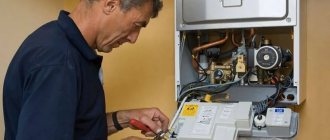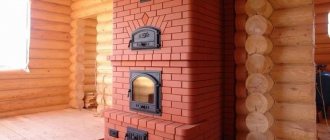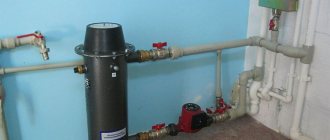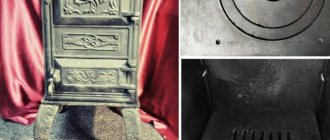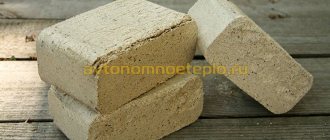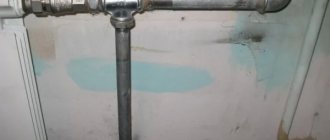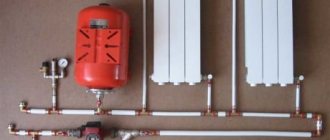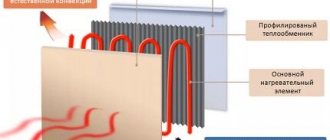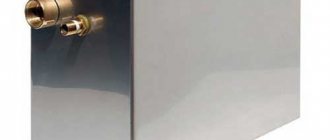When we talked about autonomous heating of an apartment, we drew your attention to the fact that electric convectors are one of the most suitable heaters. With the help of such devices, you can economically heat not only individual unheated rooms (for example, a balcony), but even the whole house. Next, we will briefly look at how to install an electric convector on a wall with your own hands, providing not only instructions, but also a visual video lesson.
Pros and cons of individual gas heating
Please note that the quality of the device, as well as the duration of its successful operation, directly depend on the price of the gas convector.
Is it possible to buy a cheap unit and connect it in the house? Yes, but keep in mind that an inexpensive model will last you no more than a year. At the same time, it is unlikely that it will be possible to repair such a convector if it fails. At the same time, it is unlikely that it will be possible to repair such a convector if it fails.
Let's consider the advantages of gas heating appliances, based on the fact that you did not save money when purchasing and purchased a high-quality unit.
Advantages of gas convectors:
- the room heats up quickly,
- economical use of fuel,
- The device can be easily installed indoors by yourself,
- reasonable price,
- a gas convector does not require installation of a heating system,
- does not destroy oxygen in the room,
- the heater can be mounted to a gas cylinder,
- the device operates in autonomous mode,
- If the convector operates on the principle of natural circulation, then it does not depend on the power supply.
Important: gas convectors with a closed combustion chamber can be installed safely in any room, including the bedroom. Disadvantages of gas convectors:. Disadvantages of gas convectors:
Disadvantages of gas convectors:
- in order to correctly install a gas convector connected to a centralized system, it is necessary to obtain permission from the relevant municipal authorities,
- the connection diagram for a gas convector requires punching a through hole in the external wall of the building, in the place where the device is planned to be installed,
- impressive size,
- if you plan to use several gas convectors for heating an apartment or house, then each of them will have to be individually supplied with gas from outside the building.
Important: experts insist on choosing models with a built-in fan. They are more efficient than similar devices with natural convection
Choice
You need to be guided by value, purpose. Can be used as backup, main heating, thermal curtain generator in front of panoramic windows, glass walls (for example, on verandas, winter gardens, greenhouses).
The second sign is the power of the device. For 10 sq. meters of area should account for 1.2-1.5 kW of power.
It is enough to purchase 2-3 devices and place them evenly throughout the room along the external walls, under the windows. It costs less than buying one powerful device, will reduce the load on the electrical network, and will create a safety margin for the heating method. If one breaks, the room will be heated by the remaining ones.
The third important factor is additional functions. They make the device comfortable and multifunctional. The mandatory number of additions includes protection against overheating, tipping over, and short circuit. Useful: air humidifier, ionizer, forced circulation, remote control.
Needle heater
General requirements
In some cases, the best way out of the situation will be to install a gas convector. This heating device is mounted on the wall and is powered by a gas cylinder. The possibility of power supply from the main line is also provided. If gas appears in your locality in the near future, purchase gas convectors. The following requirements apply to their installation:
- Mandatory maintenance of distances to the nearest objects and walls in accordance with the installation instructions;
- The gas pipe is supplied along the street;
- When installing in a household with wooden walls, it is necessary to consider thermal insulation;
- The convector should not be installed at a great distance from the floor, as this will reduce the efficiency and intensity of the convection process.
Let's see how to install such a convector on a wall.
Kinds
The principle of operation for all models is the same - they heat the air circulating between the elements of the heating devices. The heated air, becoming lighter, rises, and heavier, cooled air takes its place. Devices are divided into groups according to installation method, type of heating element, power, and additional functions.
By installation method:
- Ceiling - located almost at the ceiling of the room.
- Wall-mounted - need to be hung on the wall, just below the window openings.
- Floor-standing - can be placed in any desired place in the room, near the wall, in the center.
- Skirting boards - mounted in place of classic skirting boards along the walls.
- In-floor - immersed deep into the thickness of the floor, along large window openings, external walls.
Heating elements:
- Needle-shaped.
- Finned heating element.
- Monolithic.
Power - 1.5-2.5 kW. Models with larger and smaller characteristics are less common. A power of 1.5 kW is enough to heat a room with one external wall, an area of about 10-15 square meters. meters, 2.5-3 kW can withstand standard wiring.
Gas supply: main stages
The installation of the gas convector has been completed, now we need to get started with the gas supply. This stage is quite complex and responsible at the same time. To supply gas, do the following:
Scheme of operation of a gas convector.
- According to regulatory documents, the pipe leading to the convector must go along the street. There are two options here: the first is that the pipe has a pre-installed threaded connection, the second is that there is no such connection. If there is a thread, then you can screw on the gas valve yourself, which will shut off the gas supply to the convector. If there is no withdrawal, one must be made. To do this, call professional gas welders from your local Gorgaz or similar office.
- After installing the gas tap, it is necessary to run a metal-plastic pipe to the convector itself. Using a tape measure, calculate the length of the pipe, simultaneously determining the presence of fittings.
- You need to buy pipe and fittings. The principle of purchase is that the seller must clarify the availability of a certificate of conformity of these pipes and fittings for this type of work.
- Lay the pipe, secure it with clips every m. To install the clips, you need to drill holes in the wall.
- When installing the necessary fittings, carefully lubricate the pipe and the fitting itself with silicone, which will provide additional sealing. Silicone will also serve as a lubricant and will make pipe installation easier.
As a result of the work, you should receive a convector mounted on the wall with a gas pipe connected to it.
Now the last stage of installation remains. A test run is required.
Gas convector installation diagram.
Before starting, open the gas tap and go over all fitting joints and threaded connections with a brush moistened with a water solution of soap or shampoo. This way you will be able to notice inflated bubbles (if any), which indicate gas leaks. If this happens, immediately turn off the gas supply valve. After checking the joints, start the convector. To do this, hold down the gas button for one minute. This way the gas will have time to pass through the pipes and enter the combustion chamber. Press the piezo igniter, a spark should ignite the gas. A blue flame will flare up in the firebox.
Adjust the operation of the convector by setting a comfortable temperature. During the first few hours of operation, you may smell an unpleasant odor of burning oil. This is normal, since the convector is new and the combustion chamber burns out. If the smell lingers for a long time, then you should turn off the gas and check all joints and threaded connections again.
It is advisable that all work on the installation of gas convectors be carried out by a professional who has sufficient experience in performing such work. This is also due to the fact that installing a convector yourself may void your warranty on the device. The gas convector must be accepted into the balance sheet by Gorgaz. You must have a documented permit for the tie-in. In addition, all installation decisions, as well as the conclusions of the commission for acceptance of the device into operation, must be documented and signed in the appropriate manner.
Installation instructions
So, if you decide to install an electric convector on the wall, you need to proceed as follows:
- Unpack the convector and turn it over on the back side.
- Remove the fastening.
- Lean the removed bracket against the wall in a suitable place (where installation will be done) and mark the mounting holes with a marker.
- If the wall is wooden, screw the mount using wood screws (length 40-45 mm). If the wall is made of concrete, pre-drill the holes with a hammer drill, then drive in the dowels and install the frame, as in the photo below.
- Place the electric convector on the installed bracket.
- Connect the plug to the outlet, turn on the power.
- Set the thermostat to the appropriate temperature.
As you can see, installing an electric convector on a wall is not difficult, let alone connecting it. However, there are several nuances that need to be taken into account during installation, which we discuss below.
What is a heat exchanger
This is a technical device made of a material with a high thermal conductivity, in which two environments with different temperatures come into contact through a partition. It is through the wall of the device that temperature is transferred from one medium to another.
There are two types of heat exchangers:
- Recuperators. That is, those in which temperature transfer occurs through a partition.
- Regenerators. In them, media with different temperatures come into contact with one single surface in turn.
The principle of operation of the heat exchanger There are several types of heat exchangers, differing from each other purely in design. These are the commonly used options:
- A coil is a tube wound onto a chimney pipe through which water moves.
- Pipe in pipe. This is a cylinder-shaped structure mounted on a chimney. Water flows inside it, which enters the structure through the lower pipe, and exits through the pipe installed at the top of the heat exchanger. The liquid is heated through the chimney wall.
- Spiral. They are rarely used in everyday life, because structurally it is a container in which a pipe is laid in a spiral (along the inner walls), with a hot medium moving inside. Unfortunately, the chimney will not work in this form.
- Shell and tube. This is not a household unit. Its design is a container in which a large number of tubes are inserted. A high-temperature medium moves through them, and water moves between the tubes.
- Plate ones, they are also called convectors. This model is the same as the previous one. Only instead of tubes, there are hollow panels installed in it, through which a high-temperature medium moves. And between them there is water. The efficiency of thermal energy transfer here depends on the direction in which the media move relative to each other. Optimally – towards each other.
Spiral type heat exchanger
There is another classification in which heat exchangers are divided into water and air. The first ones were written above. As for the latter, they are mainly used to organize additional heating of premises. A prominent representative of such units is corrugated heat exchangers.
To do this, they use corrugated steel pipes (they are flexible), which are wrapped around. It turns out that high-temperature carbon monoxide gases coming from the furnace firebox give off some of the heat to the air passing inside the corrugation. The latter is connected to the street; it is usually introduced into the room through an opening located close to the floor. Sometimes a low-power fan is installed to give the air a low speed. The opposite end of the corrugation is installed in the room where the temperature needs to be raised.
Materials for heat exchangers
Usually the chimney is assembled from metal pipes. Rarely, ceramic or glass chimneys are installed in the steam room of a bathhouse or other rooms other than the main house. Too expensive. Therefore, we can safely say that these structures have high thermal efficiency. Therefore, a heat exchanger can be mounted on them.
Copper pipe coil
The material for the heat exchanger itself is selected to withstand high thermal loads, because the temperature of carbon monoxide can reach +500C. Plus, it is necessary to take into account the negative impact of water on metal. Therefore, the coil tubes must be made of either copper alloy or stainless steel.
If you decide to build a pipe-in-pipe heat exchanger, then for its manufacture it is better to use a stainless steel or galvanized structure.
Some useful tips
Sometimes it becomes necessary to install an electric convector on a balcony, the interior decoration of which is made of PVC panels. Since the weight of an electric convector can reach several kilograms, you must understand that plastic may not withstand such a load. In this case, it is recommended to choose a compact-sized electric convector, for example, like the Nobo model in the photo below.
Another nuance is the correct placement of the convector. Usually, the purchase package includes instructions in which the manufacturer himself specifies the optimal distances from the floor, windows and other objects. If in your case there is no such information, install an electric heater, taking into account the following rules and regulations:
- height from floor 20 cm;
- gap from the wall 20 mm;
- lateral distance to nearest objects – 20 cm;
- there is a gap of at least half a meter at the top and front;
- the socket is no closer than 30 cm.
Special attention should be paid to connecting the electric convector to the network. As a rule, the power of devices does not exceed 3 kW, so if you have modern electrical wiring in your house or apartment, feel free to connect the power from an outlet (they, as a rule, can withstand up to 3.5 kW). If you want to hide the cords and make a neat installation, you can even connect the electric convector directly to the mains without a plug or socket. To do this, you will have to pull a separate cable from the distribution box or even the panel (if you decide to make a separate line for heating). In this case, select 2.5 mm 2 for the cable cross-section.
Finally, we recommend watching a visual video of the installation of an electric convector:
That's all the installation instructions for this heater. We hope that now you know how to properly install an electric convector and connect it to the network with your own hands!
It will be useful to read:
Connection diagram
Water convectors are specialized equipment, so their installation is best left to professionals, especially when it comes to installing in-floor or basement types. You are only allowed to install wall-mounted water convectors yourself. In this case, it is necessary to follow a strict sequence of actions.
- It is necessary to mark the wall - using a level to determine the location of the convector itself, the place of water connection and, if necessary, electricity. Here you can either attach the radiator itself to the wall, or make markings with a ruler using the data in the product passport.
- Then the wall is drilled according to the applied markings and screwed into the dowel holes.
- Carry out the installation of pipes and electrical cables.
- The back of the convector is screwed to the wall with screws that are included in the kit. In this case, first they simply attach it to the screws, then measure the accuracy of fastening with a level, and only when they are convinced of this, screw the installation panel to the end.
- Now you need to secure the heat exchanger unit to the installation panel. For this purpose, it is allowed to use only those screws and fasteners supplied by the manufacturer.
- Now the electricity cable is connected to the terminal box. In this case, the main connection parameters are the manufacturer’s instructions and electronic circuit diagram. You must act strictly in accordance with it.
- Install the fan and, if necessary, adjust its position using a special device - a potentiometer.
- Now you can start connecting additional fittings. A thermostatic valve is installed at the inlet of the pipes, and a special threaded connection is installed at the outlet. It is imperative to check the tightness of the entire structure using an air compressor.
- Now you need to connect the pipes to the heating system. This must be done in strict accordance with the project.
- Finally, you can begin to assemble and install the water convector itself. To do this, in accordance with the diagram, install the frame, grille and thermostatic head, and attach the walls of the radiator.
- Using special adjusting screws, calibrate the location of the device on the wall, focusing on the level.
In principle, the installation of a built-in underfloor water convector is carried out in approximately the same way. Only first, when performing a rough screed, special built-in boxes are made in the floor, into which the radiator itself will later be placed.
Without any skills, it will be quite difficult to install such a water heating convector yourself for the first time. Therefore, here you either need to call a specialist, or be patient and act as carefully and slowly as possible.
Connecting your home
Dropping by
Group: Users Messages: 3 Registration: 20.2.2007 User No.: 8264
Specialist
Group: Moderators Messages: 630 Registration: 10/14/2006 From: Belgorod User No.: 7130
The price-quality ratio is best with Legrand, with Schneider in 2nd place. ABB, bitches, dears, it’s better not to mess with IEK and DEC anymore. Although due to poverty.
Take a 3-phase meter, either 10-40 or 20-50 A, an input circuit breaker - 50A, but it’s cheaper to install a switch-disconnector, divide outgoing groups and loads, for example: convectors and boilers, into phases. Lighting and sockets within the floor (if there are several of them) should be connected to only 1 phase: “1st floor - 1st phase”. It is reasonable to wire the light with 1.5 mm2 wire. and protect with 16A automatic machines; sockets, boilers and convectors (if connected in pairs) - 2.5mm.sq. and use 25A circuit breakers. I think my colleagues will recommend something more sensible.
Specialist
Group: Users Messages: 955 Registration: 1/30/2004 User No.: 832
1. There is no need to put pressure on the convector and so on in the project - you will pay extra money when handing over for the use of power for thermal purposes. There, more than 5 kW (if it has not changed) is paid. It is necessary to write in the project something like “stove heating”, and justify the loads by saying that there will be a workshop. 2. your loads: 4*1kW+2*2kW+light 6pcs*0.2kW+sockets 6pcs*1kW+ small items 2kW=17.2kW*k demand=12kW==20A. Those. a meter of 20-50 is unlikely to be suitable - it will lie 3. A 4 kW convector is 40 sq.m for 6 rooms - not enough. 4. convectors, since for themselves - each for a separate machine 10-16A 4. light - machines 10A, cable 1.5 sq. mm 5. automatic sockets + RCD 16A cable 2.5 sq. mm 6. for myself, I would make, just in case, a three-phase socket for welding with automatic switch 20-25A
Active participant
Group: Users Messages: 397 Registration: 2.5.2005 From: Lesnoy Gorod'OK User No.: 3340
Are you sure that Romario will receive permission for 3-phases? They would give me one phase.
If he clarifies how many phases he will be able to simplify, then we will count.
Specialist
Group: Moderators Messages: 630 Registration: 10/14/2006 From: Belgorod User No.: 7130
Up to 33 kW. There are only 10 kW heaters, and this is already 45.5 A, if you hang it on 1 phase. I haven’t seen any meters smaller than 10-40A for at least 1 or 3 phases on sale here. 3 phases may indeed not work, then the power supply will need to be at least 10 mm2 copper.
Specialist
Group: Users Messages: 955 Registration: 1/30/2004 User No.: 832
Active participant
Group: Users Messages: 296 Registration: 12/18/2006 User No.: 7923
You correctly address one side of the issue - how much you will consume. But there is another side - how much power will be given to you. And between the two sides, the key question is what cross-section the wires have.
Installation of gas stove and convectors
It is prohibited to install the convector at a distance of less than 4 meters from open sources of fire, including a gas stove. The hose suitable for the convector must have a dielectric insert, this will prevent a fire in the event of a short circuit in the wiring in a wooden house.
An important factor is the grounding of sockets located near the gas stove and convectors, although in a wooden house they should be grounded a priori.
There are three types of supply hoses that are allowed for a gas stove in a wooden house, namely:
- Rubber-fabric - its advantage is that it does not conduct electric current, but it is more susceptible to mechanical damage compared to analogues;
- Metal sleeve - when using it, a dielectric insert must be inserted from the gas stove to the main line, but otherwise it has the best performance among analogues. In addition, it is recommended by the latest approved standards. Its only drawback is the price, it bites;
- Rubber with metal braiding - it is more capable of withstanding serious impacts, and also, thanks to the rubber core, does not conduct current.
When purchasing a metal hose, you should pay attention to its coating; some manufacturers focused on other markets, with other standards, use yellow insulation, which does not perform its main functions. Always ask for supporting documents when purchasing, and keep them in a safe place
Is it possible to cover the convector?
When using a heater, you must not: cover the convector
cloth, hang clothes or lace napkins on it “for beauty”;
... remove the protective casing from the switched on convector
; carry out independent disassembly and repair of the device.
Interesting materials:
How to remove plaster from drywall? How to remove silicone sealant from a shower stall? How to remove spots from a suspended ceiling? How to remove old coating from furniture? How to remove old paint from a metal grill? How to remove old plaster from a wall? How to remove old liquid wallpaper? How to remove old caulk from shower? How to remove old varnish from wood? How to remove old varnish from a wooden surface?
Choosing a water convector
To select a water convector, you need to decide on the installation location and type of construction, after which you can begin thermal calculations and selection of parameters
When choosing a model, it is important to consider the following characteristics
The thermal power of a convector is a parameter showing how much area the device can heat. For 1 m2 of area of an apartment or house with a standard ceiling height, 100 W of thermal power is required. Heat loss through windows is higher than through walls, so an additional 200 W must be added to each window.
Calculation example: for a room of 20 m2 with two windows, 20·100+2·200=2400 W, or 2.4 kW, is required. It is better to distribute this value evenly across several convectors, connecting them in parallel or in series. In this case, the temperature in the room will be more stable and uniform.
What you need to know about heating convectors
Overall dimensions are another important characteristic. The possibility of installing the convector in the chosen location depends on it
In this case, it is important to take into account not only the dimensions of the device itself, but also the required distances to the floor, walls and other structures (indicated in the passport for a specific convector model). For wall-mounted convectors, the distance from the floor must be at least 80 mm, to the window sill - 100 mm
Moisture protection is an important parameter when choosing convectors for installation in a bathroom, swimming pool, sauna washing area or greenhouse. Convectors can be designed for dry rooms with an average annual humidity of up to 85% or for wet rooms with a humidity above 85%. In the second case, corrosion-resistant materials and coatings are used, and in the case of in-floor convectors, drainage systems are used.
The type of circulation (natural (KBE marking) or forced (KVP)) is important to create the necessary microclimate. Convectors with a fan can create an effective thermal curtain near doors and windows, but at the same time they actively raise dust and cause drafts. The noise level of convectors with forced circulation is also higher. The fan in convectors runs on 12 V DC, for which you need to provide a power supply.
Floor convector with tangential fan
Working pressure is a characteristic that needs to be clarified when installing water convectors; in centralized heating systems according to SNiP 2.04.05-91 it is in the range of 8-9.5 bar, in autonomous systems it usually does not exceed 3 bar. Most models of water convectors are designed for an operating pressure of 1 MPa and a pressure test of 1.6-2.0 MPa, which is equal to 10 and 16-20 bar, respectively. If this condition is met, convectors can be installed in autonomous heating in an apartment building without restrictions.
The internal volume of the heat exchanger is the most important parameter for autonomous heating systems when calculating the volume of coolant. On average, it is 0.7-2 liters and depends on the number of pipes and the length of the device.
Convector circuit
The maximum temperature for water convectors is usually +120-130 degrees Celsius, which is much higher than the permissible temperature in heating systems. At the same time, for safety of use, the maximum temperature of the device body should not exceed +60 degrees according to the passport.
The weight of the convector is important when installing wall-mounted models on walls and partitions made of plasterboard or other material with low strength. Taking into account the coolant, the weight of water convectors usually does not exceed 14-24 kg.
The degree of automation is a characteristic that takes into account the possibility of precise temperature control. Regulation is carried out by means of a thermostat and a valve; with their help, the amount of coolant necessary to maintain a given microclimate is supplied to the heat exchanger.
Thermostat
An electric convector on the wall will quickly warm up the room
All convectors basically work like this
A convector is a device that operates on the principle of thermal air movement - convection. The essence of such a heating device is that cold air approaches the heating element from below, heats up and rises upward, where it exits into special holes. A wall-mounted electric convector is an ideal option for heating individual rooms (bathroom, garage, office) and temporary dwellings (dacha, country house).
Kinds
Modern convectors are equipped with thermostats, built-in ceramic heaters and other necessary and not so necessary things. The principle of operation remains the same in any case.
Forced and natural circulation If you need to quickly heat a large area, the forced circulation option is ideal for you, although it consumes more electricity.
With or without timer
Advanced wall convector with display and timer
It is also worth noting that some modern convectors come with built-in shutdown timers and displays. Such devices are high-tech representatives of their class and can significantly save money.
For example, the Siemens 2NC8 042 4L convector can be programmed for a week so that it turns on 30 minutes before you arrive from work and turns off automatically after you leave. That is, you will always be at a comfortable temperature and not waste unnecessary electricity.
Mobile and completely stationary
Convector with wheels for easy movement
Many manufacturers make convectors that are sold immediately with wheels for floor placement. Those. they can be used permanently on the wall with brackets or to heat a separate desired area of the room by moving the heater.
There are also convectors with a remote control, which allows you to turn it on and off without getting up from the sofa/work chair. And separately, there are options with a ceramic heating element, with a longer service life than steel.
Installation
All convectors are afraid of water. Many are protected against short circuits if water gets on the heating elements, but all without exception are not designed for installation in places where direct exposure to large quantities of water is possible. For example, right next to the sink or bathtub, if you are going to bathe your child in it, in the pool, etc.
Installation procedure for wall-mounted electric convector
Because These heating elements take cold air from below, so during installation, provide at least 10 cm from the floor for a free flow of cold air. By the way, this is the optimal height for installing it, because... the lower the outlet grid of a wall-mounted electric convector is located, the greater the efficiency it provides
Advantages and disadvantages
The undeniable advantages of wall convectors are:
- Price – among electric heaters – the lowest
- The speed of heating the room - due to the fact that the air is heated, and not objects and the convector itself, the heat is felt within a few minutes after switching on
- Flexible room temperature settings. The presence of thermostats allows you to achieve a comfortable temperature by simply rotating a wheel or pressing a button.
The disadvantages include:
- High power consumption. The wall convector itself practically does not heat up, but only heats the air passing through it, so the on/off cycle depends only on the heating of all objects in the room from the air, and this takes a very long time.
- Afraid of water. But only water, not moisture. And only during work
- Dries the air. Very much. To avoid exacerbation of respiratory diseases, you should humidify the air, for which it is best to purchase a special humidifier, but this, you see, is an extra expense
Scope of application
Electric convector provides a comfort zone
It is not advisable to use wall-mounted electric convectors as the main heating due to low efficiency and poor impact on the air in the apartment. If we consider only the option of electric heating at the same price, then it is better to take an oil heater as a constant source of heat in the home, which, although it does not warm up the room so quickly, does not burn oxygen and has a higher efficiency.
Wall-mounted convectors are used in utility rooms, bathrooms, in the country, in a country house, where you can put up with their obvious disadvantages due to the fact that you are not in this room for long and they are turned on from time to time
Installation of a water convector
The basic component of this convector is the heating battery. The main goal when using water heating is that it is necessary to make the correct calculation of heating convectors in order to create the most comfortable and optimal conditions in the room by choosing the correct power of the heating convector. A specialist, instructions and special formulas will help you calculate the power of a heating convector. When installing the battery, it is also necessary to take into account the fact that radiators are made of different materials.
When installing such convectors, it is necessary to use connecting components made of copper, and they are not cheap. Such radiators are used mainly to lighten the design of the heating system. Aluminum and bimetallic radiators are used much more often. However, such radiators will also require the purchase of expensive connecting components.
The cheapest is considered to be a heating convector made of steel. Such a battery can have two types of connection:
- Bottom connection;
- Lateral connection.
Installation of a water convector, first of all, begins with fixing the radiator to the wall. To do this, you will need to drill the necessary holes and secure the hooks with which the battery will be held on the wall. It will then be necessary to hang the convector sections on these hooks. After this, the heating convectors can be connected to the heating system using the pipes. For this purpose, a heating convector connection diagram is used.
If you are using steel pipes, you will need to call a specialist, but in the case of plastic pipes, you can make the connection yourself using an iron for welding plastic. However, if you are not sure, it is better to also invite a specialist.
Installation of gas convectors for heating systems
Self-installation of a system such as a gas convection heating system is unacceptable, as the consequences can be quite dire. It is necessary to invite a specialist, and to do this under his supervision or entirely by his own efforts. In order to carry out correct installation, you must complete the following preparatory steps:
- Support legs are made. They can be made from scraps of steel or aluminum pipe.
- Using a drill, you need to make a hole of 22-23 cm in the wall if the air vent is 14.5-15 cm in size.
- A screen consisting of two layers of basalt blanket is mounted on the wall.
- Similar insulation is mounted on the outlet pipe of the gas convector.
- The convector body is mounted vertically on the wall. The convector is connected to the gas main and the heater is turned on.
Gas covector
When installing different types of convectors, the following tools and materials may be required:
- Drill and drill bits with different diameter sizes;
- Simple and anchor bolts;
- Chisel and hammer;
- Stainless steel sheets;
- Basalt thermal insulation;
- An iron designed for welding plastic;
- Grinder, you can also use a hacksaw.
- Plastic pipes;
- Pipe scraps and other various materials.
Installation of heating convectors, taking into account power calculations
The main purpose of household convectors is heating a living space. There is a division of this type of equipment in accordance with the characteristics of the installation, as well as based on the coolant used in the design.
Speaking about installation methods, you can find floor and wall models, and the use of one or another coolant divides these devices into mechanisms that operate using water, electricity and gas
It is important to remember that installation of gas-type heating convectors can only be carried out on walls in a vertical position, while water and electrical systems can be installed both on the wall and on the floor (read: “Household convector: principle of operation and installation”)
Special standards for the operation of convectors
When using this heating equipment, it is important to ensure its normal operation, and this can be achieved not only by correctly installing the system, but also by following the rules for its operation described below:
- The upper and lower grilles of the convector must be cleaned of dust at least twice a year, and this can be done either with a brush or with a regular vacuum cleaner. The design of the device allows you to easily reach important functional parts and provide them with proper care;
- The body of the device can be wiped with either a dry or a cloth moistened with water, but you should not use any special detergents at all.
Work specifics
Today, heat exchangers of various types are produced. In general, the features of their operation, as well as the design characteristics, are similar. The structural properties of such an element:
- Full body available.
- Presence of outlet and outlet pipes.
- Braking mechanism for combustion products. Its role is played by valves with cutouts that are installed on the axles.
The flaps can be turned. A zigzag chimney of varying lengths is formed. The valves can be adjusted to ensure the ratio of draft and heat transfer is as efficient as possible. Safety standards are met.
In this video you will learn how to make a heat exchanger:
General requirements
In some cases, the best way out of the situation will be to install a gas convector. This heating device is mounted on the wall and is powered by a gas cylinder. The possibility of power supply from the main line is also provided. If gas appears in your locality in the near future, purchase gas convectors. The following requirements apply to their installation:
- Mandatory maintenance of distances to the nearest objects and walls in accordance with the installation instructions;
- The gas pipe is supplied along the street;
- When installing in a household with wooden walls, it is necessary to consider thermal insulation;
- The convector should not be installed at a great distance from the floor, as this will reduce the efficiency and intensity of the convection process.
Let's see how to install such a convector on a wall.
Advantages, disadvantages
Advantages:
- Easy to install and operate. It comes down to three steps: remove the packaging, hang it on the wall, plug it into the socket. The controls are intuitive.
- Reliability, long service life - up to 15-20 years. Virtually no moving parts, proven designs.
- Safety - maximum heating temperature of the thermoelement is 80 degrees. Fire and serious burns are not possible. Location on the wall or ceiling reduces the risk to a minimum.
- Environmentally friendly - does not burn oxygen.
- Efficiency - up to 97%.
- You can fit the convector into any interior by placing it on the wall, ceiling, or floor.
The disadvantage is the cost of electricity needed to operate. But, due to rising prices for other energy sources, the disadvantage is less noticeable in comparison with the advantages.
Floor recessed design
Installation of electric convectors
Another option for such equipment is electric convectors
These models can be installed and connected by hand, but it is very important to correctly calculate the power of a convector of this type
The algorithm for installing this device should be as follows:
- the device must be removed from its packaging;
- then the protective film must be removed from the convector;
- Next, you need to decide where the mechanism will be installed.
When calculating the power of a heating convector operating using electricity, as well as connecting it, it is extremely important to follow a large number of recommendations, which, nevertheless, will allow for high-quality installation of the equipment. Here are some of them:
Here are some of them:
- the minimum distance from the floor to the convector is 20 – 25 cm;
- the device must be located at least 25 cm from nearby objects, from above and in front - at least 24 - 55 cm;
- the convector should be installed at a distance of 25 cm from the wall, and it should be located at least 35 cm from the ceiling;
- It is strictly not recommended to install the device behind curtains and doors, as well as under openings intended for ventilation.
The installation process for an electric convector is as follows:
- Having unscrewed the fastening bolts, you need to pull out the bracket;
- using a drill, you need to make pre-marked holes intended for fastening the mechanism;
- Next you need to fix the bracket;
- then you need to insert the electric convector into the clamp with its lower part;
- Guys should be placed on the equipment;
- it is necessary to place the upper part of the device into the mounted guy wires;
- after this, all the clamps must be tightly secured, and the fixing bolts must be screwed in;
- The convector operation regulator should be set to off mode and power should be supplied to the device;
- After the LED on the device lights up, the equipment can be switched to operating mode.
If the electric convector used is floor-standing, then its connection is as follows:
- The unit must be turned over and the mounting legs equipped with wheels must be secured to it. Standard bolts can serve as fastening elements;
- After this, the convector can be turned on and set to the desired operating mode.
It is important to remember that the power consumption of the convector is one of the factors that must be taken into account when selecting and installing equipment
Advantages of household convectors
The undeniable advantages of convectors used for heating domestic and commercial premises include many factors that make it possible to reliably and efficiently heat the required area. The operating principle of the convector is not based on the use of the usual tubular electric heaters (TEH), but on the use of special functional parts constructed using a special alloy. One of the advantages of this method of arrangement is that the room warms up very quickly, since there is no energy consumption to warm up the device itself. Moreover, the productivity rate of these products is very high and is more than 90%.
Troubleshooting
As you can see, there is nothing complicated in the design of a gas convector. Due to its simplicity, this equipment serves for a long time and with high quality. But sometimes it happens that incomprehensible interruptions arise in its work. If you notice that the flame burns unevenly or is difficult to ignite at all, the problem is often a clogged nozzle.
Simply put, the hole through which the gas escapes becomes clogged with soot or other contaminants. In this case, you can easily clean it yourself. All you need for this is a thin needle. Use it to carefully clean the hole.
Very important: before starting work, be sure to shut off the supply of blue fuel to the equipment. For this purpose, a special tap is provided on the supply pipe.
It is absolutely forbidden to work with the device when gas enters it!
It is absolutely forbidden to work with the device when gas enters it!
If after cleaning the problem does not disappear, then the most reasonable option for further action would be to call a specialist from a specialized organization. Remember that gas equipment has a high fire hazard. All more or less serious work with it should be carried out only by craftsmen who have the appropriate license.
If you decide to repair the gas convector yourself, but do something wrong, this is fraught not only with subsequent fines from the gas service, but also with the possibility of a fire. You should not take such responsibility upon yourself; be sure to invite specialists to troubleshoot serious problems. Good luck and a warm home!
Installation process
Let's see how to install a convector with your own hands - no help from specialists is needed here. First, you need to remove the device from the box and tear off the polyethylene packaging from it. At the next stage, we get acquainted with the instructions - a mandatory requirement, but ignored by 99% of users (nothing can be done - this is how the mentality of the Russian person manifests itself, who turns to the instructions only when nothing really helps).
Related article: Decorative gypsum panels for interior wall decoration
Next you need to figure out how to hang the convector. For this, in most cases, special brackets are used that are attached to the walls - they are similar to the brackets used to install LCD TVs. The next stage involves working with a drill; you need to go through four holes in the wall, push plastic dowels into them and hang brackets on them using self-tapping screws. The length of the dowels used is 40-50 mm.
Next, we install the convector on the brackets placed on the wall - we simply hang the device on the appropriate hooks. Now everything is ready for launch and operation. Connect the equipment to the outlet, set the desired temperature using the thermostat and wait until the electric heater warms up the air in the room - this may take 1-2 hours, depending on the volume.


